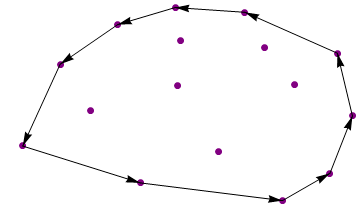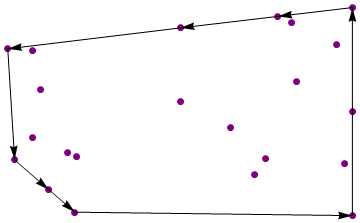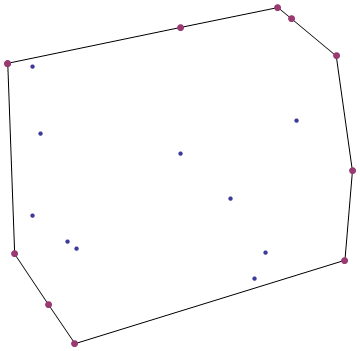20
7
When you hammer a set of nails into a wooden board and wrap a rubber band around them, you get a Convex Hull.

Your mission, should you decide to accept it, is to find the Convex Hull of a given set of 2D points.
Some rules:
- Write it as a function, the point's list coordinates (in any format you want) is the argument
- The output must be the list of points in the convex hull listed clockwise or anticlockwise, starting at any of them
- The output list can be in any reasonable format where each point's coordinates are clearly distinguishable. (For example NOT a one dim list { 0.1, 1.3, 4, ...})
- If three or more points in a segment of the convex hull are aligned, only the two extremes should be kept on the output
Sample data:
Sample 0
Input:
{{1, 1}, {2, 2}, {3, 3}, {1, 3}}
Output:
{{3, 3}, {1, 3}, {1, 1}}
 (The figures are just illustrative)
(The figures are just illustrative)
Sample 1
Input:
{{4.4, 14}, {6.7, 15.25}, {6.9, 12.8}, {2.1, 11.1}, {9.5, 14.9},
{13.2, 11.9}, {10.3, 12.3}, {6.8, 9.5}, {3.3, 7.7}, {0.6, 5.1}, {5.3, 2.4},
{8.45, 4.7}, {11.5, 9.6}, {13.8, 7.3}, {12.9, 3.1}, {11, 1.1}}
Output:
{{13.8, 7.3}, {13.2, 11.9}, {9.5, 14.9}, {6.7, 15.25}, {4.4, 14},
{2.1, 11.1}, {0.6, 5.1}, {5.3, 2.4}, {11, 1.1}, {12.9, 3.1}}

Sample 2
Input:
{{1, 0}, {1, 1}, {1, -1}, {0.68957, 0.283647}, {0.909487, 0.644276},
{0.0361877, 0.803816}, {0.583004, 0.91555}, {-0.748169, 0.210483},
{-0.553528, -0.967036}, {0.316709, -0.153861}, {-0.79267, 0.585945},
{-0.700164, -0.750994}, {0.452273, -0.604434}, {-0.79134, -0.249902},
{-0.594918, -0.397574}, {-0.547371, -0.434041}, {0.958132, -0.499614},
{0.039941, 0.0990732}, {-0.891471, -0.464943}, {0.513187, -0.457062},
{-0.930053, 0.60341}, {0.656995, 0.854205}}
Output:
{{1, -1}, {1, 1}, {0.583004, 0.91555}, {0.0361877, 0.803816},
{-0.930053, 0.60341}, {-0.891471, -0.464943}, {-0.700164, -0.750994},
{-0.553528, -0.967036}}

Standard code-golf rules apply. No ad-hoc geometry libraries. Shorter code wins.
Edit 1
We are looking for an algorithmic answer here, not a convex hull finder pre-programmed routine like this one in MatLab or this one in Mathematica
Edit 2
Answering comments and additional info:
- You can assume the input list contains the minimum number of points that suits you. But you must ensure proper treatment of aligned (sub)sets.
- You may find repeated points in the input list
- The maximum number of points should be limited only by the available memory
- Re "floating point": You need to be able to process input lists with decimal coordinates as those given in the samples. You could do that by using a floating point representation
.

2
I predict that MATLAB will win this one.
– Paul R – 2013-03-27T16:41:33.947Can we assume that there are at least 3 points? Can we assume that the points are distinct? Are we required to support floating point coordinates? – Peter Taylor – 2013-03-27T17:25:58.453
@PeterTaylor the example indicates the last answer is true – John Dvorak – 2013-03-27T17:27:57.180
May we overwrite the input? – John Dvorak – 2013-03-27T17:32:13.403
The problem with treating collinear points consistently is there are rounding issues. We should be allowed to make mistakes. – John Dvorak – 2013-03-27T17:47:09.833
@JanDvorak 1) You can overwrite the input if that is useful for you. 2) Collinearity detection: perform it up to your rounding ability, or use http://en.wikipedia.org/wiki/Arbitrary-precision_arithmetic if you dare
– Dr. belisarius – 2013-03-27T17:57:52.940@belisarius so, I am allowed to assume floats are infinitely precise – John Dvorak – 2013-03-27T18:01:40.900
@JanDvorak Yes. – Dr. belisarius – 2013-03-27T18:07:34.367
You might also want reasonable running time (eg. under 1 sec for examples) to avoid brute force check-every-possibility solutions. – randomra – 2013-03-27T18:51:08.767
@randomra Why not allow brute-force solutions? I don't think they can get substantially shorter than polynomial solutions. – John Dvorak – 2013-03-27T18:59:40.367
@randomra No time limits, No specific algorithm requirement. Brute force it if that makes you happy :) – Dr. belisarius – 2013-03-27T19:36:53.960
Yes, that answers my questions. Thanks. – Peter Taylor – 2013-03-27T21:59:15.767
There's a typo in sample 1. The output contains a point
{9.5,14.9}but no such point exists in the input. I think the{9.5,4.9}in the input is supposed to be{9.5,14.9}. – cardboard_box – 2013-03-28T23:49:48.770@cardboard_box Thank you! The "1" was unintentionally deleted while editing the list – Dr. belisarius – 2013-03-28T23:54:45.493